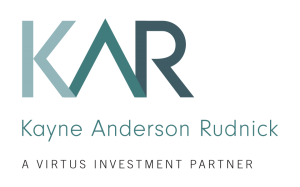Virtus Strategic Allocation Series
Virtus Strategic Allocation Series
Investment Overview
The Series seeks to achieve both long-term capital growth and income through a balanced portfolio of global stocks and bonds. Disciplined fundamental analysis is utilized to construct a diversified portfolio allocated to approximately 60% equity (15% non-U.S.) and 40% fixed income.
Investment Partners
Kayne Anderson Rudnick Investment Management, LLC
Kayne Anderson Rudnick believes that superior risk-adjusted returns may be achieved through investment in high-quality companies with market dominance, excellent management, financial strength, and consistent growth, purchased at reasonable prices.
Learn more about Kayne Anderson Rudnick Investment Management, LLC
Newfleet Asset Management
Newfleet Asset Management leverages the knowledge and skill of a team of investment professionals with expertise in every sector of the bond market, including evolving, specialized, and out-of-favor sectors. The team employs active sector rotation and disciplined risk management to portfolio construction.
Newfleet Asset Management is a division of Virtus Fixed Income Advisers, LLC ("VFIA"), an SEC registered investment adviser.
Learn more about Newfleet Asset Management
Investment Professionals

Douglas S. Foreman, CFA
Co-Chief Investment Officer, Portfolio Manager
Industry start date: 1986
Start date as fund Portfolio Manager: 2016

Craig Thrasher, CFA
Portfolio Manager and Senior Research Analyst
Industry start date: 2003
Start date as fund Portfolio Manager: 2019

Hyung Kim
Portfolio Manager and Senior Research Analyst
Industry start date: 2004
Start date as fund Portfolio Manager: 2019

Chris Armbruster, CFA
Portfolio Manager and Senior Research Analyst
Industry start date: 2004
Start date as fund Portfolio Manager: 2020

David L. Albrycht, CFA
President and Chief Investment Officer
Industry start date: 1985
Start date as fund Portfolio Manager: 2007

Stephen H. Hooker, CFA
Managing Director and Portfolio Manager
Industry start date: 1993
Start date as fund Portfolio Manager: 2017

Noran Eid, CFA
Portfolio Manager and Senior Research Analyst
Industry start date: 2006
Start date as fund Portfolio Manager: 2023
Key Features
Balances Risk and Reward
Leverages diverse investment expertise from across Virtus to deliver a professionally managed 60/40 equity/fixed income allocation in a single portfolio
Global Equity Exposure
Extensive fundamental research guides discrete, actively managed investment styles in the U.S. equity and international equity allocations
Multi-Sector Fixed Income Exposure
Employs a time-tested approach of active sector rotation, extensive credit research, and disciplined risk management
Top Holdings (% Series)
| Security | |
|---|---|
| NVIDIA Corp | |
| Visa Inc | |
| Amazon.com Inc | |
| United States Treasury Note/Bond, 3.6250% 02/15/2053 | |
| Meta Platforms Inc | |
| Amphenol Corp | |
| Fair Isaac Corp | |
| Uber Technologies Inc | |
| Marriott International Inc/MD | |
| Trade Desk Inc/The |
Holdings are subject to change.
Characteristics4
(as of 03/28/2024)| Average Weighted Market Cap (billions) | $411.80 |
| Median Market Cap (billions) | $28.66 |
| Trailing P/E Ex-Negative Earnings | 36.10 |
| Price-to-Cash Flow | 28.71 |
| Price-to-Book Value | 6.82 |
| 3-Year Earnings Growth Rate | 15.95 |
Sector Allocation (% Equity)
| Information Technology | |
| Consumer Discretionary | |
| Communication Services | |
| Financials | |
| Industrials | |
| Health Care | |
| Consumer Staples | |
| Real Estate | |
| Materials | |
| Energy |
Growth of $10,000 Investment
From toPerformance
Performance data quoted represents past results. Past performance is no guarantee of future results and current performance may be higher or lower than the performance shown. Investment return and principal value will fluctuate, so your shares, when redeemed, may be worth more or less than their original cost.
Returns for periods of less than one year are cumulative total returns.
Sales Charge and Expenses
Risk Statistics3
(as of )| Fund | Index | |
|---|---|---|
| R2 | ||
| Beta | ||
| Alpha | ||
| Std Dev |
Risk Considerations
Holdings
Financial Materials
The investments for the Virtus Variable Insurance Funds (the “Funds”) are managed by the same portfolio manager(s) who manage one or more other funds that have similar names, investment objectives, and investment styles as the Funds. You should be aware that the Funds are likely to differ from the other mutual funds in size, cash flow pattern, and tax matters. Accordingly, the holdings and performance of the Funds can be expected to vary from those of the other mutual funds.
Shares of the Funds are sold only through the currently effective prospectuses and are not available to the general public. Shares of the Funds may be purchased only by life insurance companies to be used with their separate accounts which fund variable annuity and variable life insurance policies or qualified retirement plans and are also available as an underlying investment fund for certain qualified retirement plans. The performance information for the Funds does not reflect fees and expenses of the insurance companies. If such fees and expenses were deducted, performance would be lower.
Please carefully consider the investment objectives, risks, charges, and expenses of the Virtus Variable Insurance Funds before investing. For this and other information about any Virtus Variable Insurance Fund, call 1-800-367-5877 or visit Virtus.com for a prospectus and/or summary prospectus. Read it carefully before you invest or send money.
Morningstar Disclosures:
The Morningstar Rating™ for funds, or "star rating", is calculated for managed products (including mutual funds, variable annuity and variable life subaccounts, exchange-traded funds, closed-end funds, and separate accounts) with at least a three-year history. Exchange-traded funds and open-ended mutual funds are considered a single population for comparative purposes. It is calculated based on a Morningstar Risk-Adjusted Return measure that accounts for variation in a managed product's monthly excess performance, placing more emphasis on downward variations and rewarding consistent performance. The top 10% of products in each product category receive 5 stars, the next 22.5% receive 4 stars, the next 35% receive 3 stars, the next 22.5% receive 2 stars, and the bottom 10% receive 1 star. The Overall Morningstar Rating for a managed product is derived from a weighted average of the performance figures associated with its three-, five-, and 10-year (if applicable) Morningstar Rating metrics. The weights
© year Morningstar, Inc. All rights reserved. The information contained herein: (1) is proprietary to Morningstar and/or its content providers; (2) may not be copied or distributed; and (3) is not warranted to be accurate, complete, or timely. Neither Morningstar nor its content providers are responsible for any damages or losses arising from any use of this information. Past performance is no guarantee of future results.
1 Yields/Distributions: Distribution Yield (at NAV) is calculated by annualizing the latest month's distribution and dividing by the NAV on the last business day of the period. SEC Yield represents the net investment income earned by a fund over a 30-day period (7-day period for Money Market Funds), expressed as an annual percentage rate based on the fund's public offering share price at the end of the 30-day period (7-day period for Money Market Funds).
2 Distribution History: Distributions are represented on a cash basis and may be reclassified at year end for tax purposes. The Fund will send you a Form 1099-DIV for the calendar year that will tell you how to report these distributions for federal income tax purposes. STCG: Short Term Capital Gain, LTCG: Long Term Capital Gain
3 Risk Statistics: R2 is a statistical measure that represents the percentage of a fund or security's movements that can be explained by movements in a benchmark index. Beta is a quantitative measure of the volatility of a given portfolio to the overall market. Alpha is a risk adjusted measure of an investment's excess return relative to a benchmark. A positive Alpha indicates that the investment produced a return greater than expected for the risk (as measured by Beta) taken. Standard Deviation measures variability of returns around the average return for an investment fund. Higher standard deviation suggests greater risk. Risk Statistics are calculated using 36 monthly returns.
4 Characteristics: For Equity Funds: Avg. Weighted Market Cap (bn): The sum of each security's weight within the fund (or index) multiplied by the security's market capitalization. Trailing P/E-Negative Earnings: Per-share stock price divided by the latest 12-months Earnings per Share; Price/Cash Flow: Per-share stock price divided by the per-share operating cash flow; Price/Book: Per-share stock price divided by the latest 12-month per-share Book Value; 3-Year EPS Growth Rate: Average of earnings per share growth for latest 3-year period. The 3-Year EPS Growth Rate is not a forecast of the fund's performance.
4 Characteristics: For Fixed Income Funds: Effective Duration represents the interest rate sensitivity of a fixed income fund. For example, if a fund's effective duration is five years, a 1% increase in interest rates would result in a 5% decline in the fund's price. Similarly, a 1% decline in interest rates would result in a 5% gain in the fund's price.
Not insured by FDIC/NCUSIF or any federal government agency. No bank guarantee. Not a deposit. May lose value.

